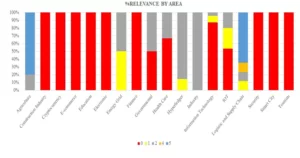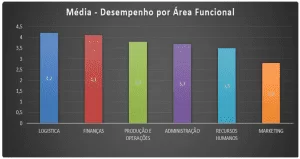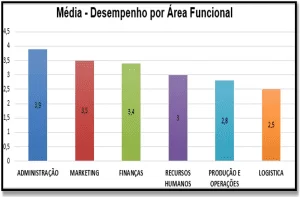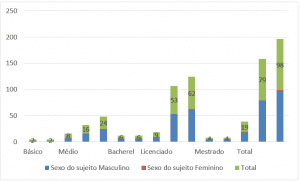ORIGINAL ARTICLE
GUIMARÃES JUNIOR, José Carlos [1]
GUIMARÃES JUNIOR, José Carlos. PESTEL analysis applied to the Nucleus of Indigenous Culture and Art of Barcelos-NACIB, in Barcelos – AM. Revista Científica Multidisciplinar Núcleo do Conhecimento. Year 06, Ed. 07, Vol. 08, p. 100-111. July 2021. ISSN: 2448-0959, Access link: https://www.nucleodoconhecimento.com.br/business-administration/indigenous-culture
ABSTRACT
This article aimed to characterize the Nucleus of Indigenous Culture and Art of Barcelos-NACIB, the importance of the participation of this entity in the local economy, as well as the presentation of scenarios for the improvement of the handicraft production activity after the pandemic period of the new Coronavirus. Thus, the PESTEL analysis tool was used to prospect scenarios in Political-Legal, Economic, Sociocultural, Technological and environmental environments, in order to assess the external environment. It is expected that there will be a return to routine activities from the moment that all its members are immunized, thus offering greater security to its members, thus promoting continued growth, but we are still at a slow pace with regard to the process of immunization of the entire population of Brazil.
Keywords: Pestel Analysis, Nacib, Barcelos-AM.
1. INTRODUCTION
The PESTEL analysis is a tool that analyzes political, economic, technological, social, environmental and legal moments, where it is used according to the understanding of the regional and world scenario, seeking to identify the micro and macro environmental factors that impact on all relationships, and thus seeks to plan strategies for the good performance of the business.
Aguilar (1967) defines the PESTEL analysis as one of the most widespread strategic tools for conducting environmental analysis, which guides the analysis of Political, Economic, Sociocultural, Technological, Environmental and Legal dimensions. It serves as a tool for understanding and analyzing the systemic external environment, assisting in eventual decisions for organizational activities.
According to Ho Joseph (2014), the PESTEL analysis not only analyzes the isolated organizational environment, but also investigates social and physical variables, with regard to the organizational structure that are external to the organizational environment, and thus, in the process of production of biojewels, identifying the relationships between all the actors, as well as their relationships with the handicraft market in the region and in Brazil, vis-à-vis other suppliers and traders in the market as a whole.
The PESTEL analysis, applied in this article, is a refinement of the PEST analysis[2], which means Political, Economic, Social and Technological. However, with the evolution of this, the legal and environmental part was included, becoming known as PESTEL.
Gupta (2013), “in addition, its application is very generic in its foundation, creating difficulties in understanding which rules to establish when we are faced with variable circumstances in a practical application”.
Therefore, companies, organizations and associations, in a global analysis asparagus, will have to carry out different PESTEL analysis, taking into account each micro-region where the referred organization is inserted, while promoting the analysis at a global level, taking into account taking into account that each geographic region that is being analyzed has its particular regional characteristics, as well as all its socio-cultural evolution.
To Johnson; Scholes and Whittington (2005), when organizations use the PESTEL analysis, it becomes easier to perceive and identify the main indicators of changes and conflicts, through political, economic, social, technological, environmental (ecological) and legal means. These data, when generating the indicators, can be used in the construction of future scenarios providing success or failure of the strategies of an organization or governmental program.
All these external and indirect circumstances have the capacity to influence the company’s ability to produce value and, in this sense, the PEST analysis serves as a “panoramic photograph” that helps the company to better understand and evaluate its entire external environment (GUO and NUNES). , 2007).
Thus, the use of this tool sought to identify the external and macro-environmental factors that act in the Attalea funifera production chain and in NACIB activities, seeking to promote the interrelationship between the production process and the commercialization of handicrafts, grouping these variables into factors , political, economic, social, technological and environmental and legal.
Still commenting on the concept of the PESTEL analysis, Ribeiro (2016) these authors cite that “it represents the starting point for the analysis of important environmental influences in the past, and potential changes to occur in the present with repercussions on the future of the organization and its competitors”.
The application of this tool, therefore, took place through political, economic, social, technological, environmental and legal analysis, promoting a broad aspect, seeking to optimize and use the tool provided.
This research is justified by the need to better understand the business of the handicraft sector at NACIB, analyzing the variables that influence the process of production and commercialization of biojewels, in addition to offering alternatives for leveraging sales, thus promoting a better positioning in the market. biojewels market, in Brazil and in the world.
2. METHODOLOGY
This research is of a pure nature because it seeks to generate new knowledge about the activities carried out within the scope of the Nucleus of Indigenous Culture and Art of Barcelos-NACIB, and in this way it was possible to explore the still little known theme, which comprises the activities performed by these actors. in the municipality of Barcelos. Thus, efforts were made to describe the actions and explain the determining factors with significant effects of the activities.
As technical procedures, the research was based on bibliographies and documents produced on handicrafts in Brazil and in the state of Amazonas, therefore, using secondary data, information that made it possible to carry out a case study of the Nucleus of Indigenous Culture and Art of Barcelos (NACIB) , using field research with all members of this Association, generating primary information, and thus it is a non-qualitative research because it analyzes non-measurable information, at the same time that it generates quantitative data.
3. CHARACTERIZATION OF NACIB
NACIB was created in 2012, from the meeting of some indigenous representatives from the municipality of Barcelos – AM, who, concerned with maintaining their culture and traditional knowledge for future generations, wanted to create an Entity in order to promote activities related to craftsmanship.
The idea, structured by the general coordinator Dinalva Campos, was to represent artisans, farmers and other indigenous workers, seeking partnerships through insertion in the market and the dissemination of handicraft work. NACIB was made up of 20 active members in its organization, who act in a very influential way in the activity of handicraft production with forest products and are a reference in the production of biojewels throughout the region.
Nucleus of Indigenous Culture and Art of Barcelos – The working conditions of the artisans in the association are reasonable, despite the fact that they do not have their own headquarters, the meetings always take place at the residence of one of the members, once a month, on weekends or when carrying out an event. When opportunities arise, association members expose their products at the Barcelos Municipal Market and, on weekends, at stalls in the city’s central square, or even next to the municipal airport, especially during the sport fishing season, which takes place between months from July to December.
For the development of this work, it was necessary to observe the routine practices of the Attalea funifera chain and the production of handicrafts by NACIB members in the search for raw material in the forest, such as lianas and Attalea funifera, used in the making of baskets and bio-jewels, and in the process of building economic opportunities, from the point of view of a product that has a raw material originating from biodiversity. (GUIMARÃES JUNIOR, 2021).
The incipient search that this article was based on refers to the construction of referential elements that encourage society’s reflection on the reality of Amazonian life on the existing bottlenecks for the promotion of local development and the regional economy, from the perspective of NACIB artisans.
In this way, the division of this work was established, considering the milestones of the construction of thought in a dialectical way, both in the dialogue with the interviewees and with the actors of the production chain, represented by the artisans of NACIB, as well as offering concepts and timely information for the best understanding of this reality.
Thus, it becomes important to identify the context of the activity in disagreement with the rules imposed on NACIB artisans, seeking to understand the positions of the actors; the arguments that are defended and criticized during conflicts; the evolution of debates around probable changes in behavior, and what paths these actors should take. In addition, the importance of activities developed by the Nucleus of Indigenous Culture and Art of Barcelos (NACIB) is highlighted, an organization that develops handicraft production activities, whose raw material is Attalea funifera, from the perspective of PESTEL Analysis. In this way and in order to highlight this importance, graph (1) was prepared below, where it presents the activities developed in Barcelos, with their respective percentages of importance of participation in the generation of revenue for the municipality.
Graph 1 – Economic activities in Barcelos – AM.
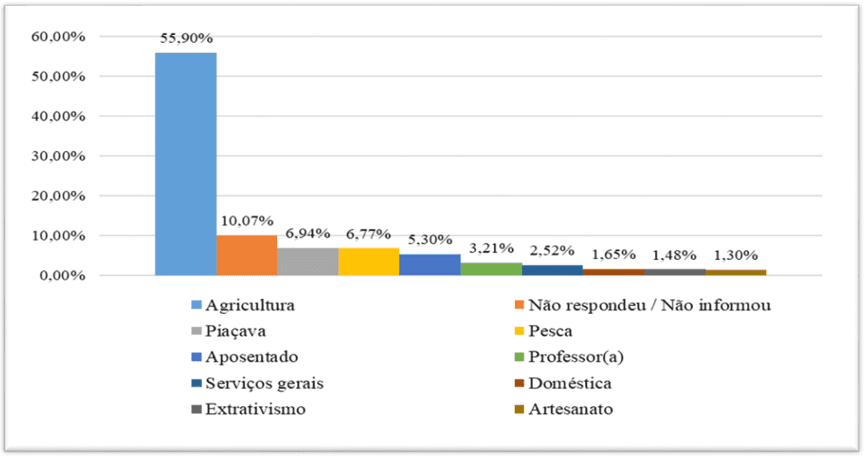
The continuity of economic practices centered on extractivism to guarantee access to such products results in the scarcity and localized reduction of several resources. Therefore, the control of access to these natural resources existing within the limits of the communities, together with the elaboration of rules that seek to regulate the form of exploitation, in addition to defining who has the right to exploit them, must be an alternative for better managing latent social, economic and environmental conflicts.
It was necessary to promote the characterization of the NACIB, identifying and analyzing the activities of the artisans, as well as the social, economic and cultural characteristics of the members, stimulating the discussion about the social aspects and the capacity that the activity of handicraft production offers members to generate and improve the socio-economic levels of artisans.
The case study of NACIB is due to its importance for bringing together artisans who have traditional knowledge in handicraft making, using Attalea funifera as a raw material, in addition to seeds taken from the forest. The interviewees were the actors who were willing to participate in the research and who acted as extractivists, the intermediaries in the commercialization of fiber, and the artisans of the NACIB.
Through the data obtained in the application of the questionnaire and the observations made mainly with regard to the activities of handicraft production by the artisans of NACIB, we segment the variables into six different categories, they are: political, economic, social, technological, Environmental and Legal; being that for each one of them, one or more variables are mentioned and how each of them can affect the company and its profit (both positively and negatively), and thus, we prepared Table (1), to better explain the PESTEL analysis in the Attalea funifera and NACIB production chain.
TABLE 1: Variables and Scenarios – Analysis of Handicraft Production
| Variables | Scenarios |
| Politicians | – Political factors are fundamental, as fiber traders, represented by associations and cooperatives, in addition to the production of handicrafts by NACIB, as both need political stability to continue their operations. |
| Sociocultural | – With regard to the production of handicrafts by NACIB artisans; we have already shown, through the answers obtained when applying the questionnaire, several socioeconomic situations that reflect the situation of these professionals.
– In general analysis, we can report that all members have the same indigenous origin, but with different ethnicities, but that their cultures do not affect labor relations in the production of handicrafts, therefore not influencing their workforce. |
| Technological | – With regard to the production of handicrafts, under no circumstances are artisans interested in inserting some kind of technology into the handicraft production process that can offer greater production of the pieces. |
| Environmental | – As for the production of handicrafts, the growing concern about the environment among all countries, where consumers seek products from companies that produce their products with environmental responsibility and socially effective, thus valuing the traditional knowledge expressed in the handicrafts .
– This demand has become more important due to the increasing scarcity of raw materials in addition to the use of raw materials originating from the forest. |
| Legal | – As for the NACIB, until 2012, the Association did not have registration with the Commercial Board of the State of Amazonas, a situation that prevented several business opportunities with other companies and traders who need an invoice so that they could purchase their products and promote the formally transport.
– From that year (2012), the market opportunities for the NACIB, innumerable other business opportunities have arisen that have already been captured and implemented, in addition to giving the Association and its members the condition to have access to credit lines and public policies . – The implementation of the process of exporting your handicrafts is already at an advanced stage, where at first it will be the development of an application that will have all your handicrafts available to customers. |
Source: Author, 2021.
The factors highlighted in the PESTEL Analysis must be understood by the artisans of NACIB, as a strategic planning tool to improve relations in the production chain, as well as improving the process of commercialization of handicraft biojewels.
In the use of the PESTEL tool, in the analysis of the Nucleus of Indigenous Culture and Art of Barcelos-NACIB, with regard to its forms of governance, it was possible to carry out a diagnosis of the actions that incur in the development of activities.
Among the main results of this research, we highlight the fact that the analyzes referring to the activities of the handicraft production process, and taking into account all the actors involved in this activity, care must be taken in proposing actions that interfere with the an existing process, considering that the regional reality and specifically of this activity, does not allow radical changes without all strategic planning where efficient and effective public policies definitely reach all these actors.
One cannot ignore the obstacles that exist in the day-to-day of this activity, since the actions of public bodies, whether in the form of offering public policies or better conditions for extractive workers to survive from this activity, are far short of what was identified. during the conduct of the research. These new strategies must be used in the face of existing threats of a good relationship in the production chain, providing good growth opportunities for all members of the chain.
With regard to the Nucleus of Indigenous Culture and Art of Barcelos – NACIB, the identification of the existing reality in the internal relations between the artisans and the processes of commercialization of biojewels was important in the sense that the proposition of the changes in these relations, must be very well structured and put into practice in an incremental way without the culture and habits identified undergoing any kind of change to the point of causing some form of misunderstanding among its members.
Therefore, it is necessary to promote a periodic evaluation of the internal relations of its members, as well as the positioning of NACIB in the handicraft market.
4. FINAL CONSIDERATIONS
The Nucleus of Indigenous Culture and Art of Barcelos-NACIB, is an Association of Artisans that maintains a highly relevant associated role, as it provides greater aggregation among its members, and is an Association that guides the negotiations carried out by this group with local traders. and companies from other states.
In the analysis carried out during the research phases and using coherence, several conflicts in the Attalea funifera production chain between the various actors that make up this relationship were observed, which are often caused by economic and survival interests on the part of extractivists.
In an analysis of the NACIB, it is no different, as its members, even if they are organized, see diffuse interests with regard to individual interests.
The NACIB coordinator is the person who assumes all the responsibilities of the Association, guides its members from the best practices to seek the raw material for making handicrafts in the forest, whether vines, Attalea funifera or seeds, defines the roles of each member and makes the necessary decisions so that the activity can always progress.
Thus, it is possible to identify that the figure of the elected coordinator is a natural leader, who has the support and respect of all members and other people who interact with the Association, and this leadership is recognized in a very perceptible way when talks with residents and merchants of the city of Barcelos, in addition to some representatives of agencies, Sebrae for example.
The Attalea funifera production chain offers a commercial relationship of great social and commercial, social and environmental prominence throughout the municipality, where all production is attended by the extractivism process, generating income for all actors involved in the activity, providing original raw material. for the production of handicrafts by artisans, without any kind of conflict, either by the quantity acquired from the fiber traders, or by the origins of its members, a fact that could, in some way, promote some kind of conflict with regard to their cultures, focusing on the process of making handicrafts.
5. RECOMMENDATIONS
NACIB already has several interested traders and buyers of its products, but it needs greater coordination to be able to organize itself administratively, in the sense of developing strategies that can take its products to more distant places, whether in the national and international market mainly, where the acceptance , already identified, was very positive. In order for the action to reach international markets to be successful, it needs to articulate the entire production process more effectively, with a view to having a certain amount of parts in stock so that they do not run out in the event of a large order.
It is therefore necessary to reflect on a business plan for this activity, which can be achieved through the incubation of the association in entities that offer this offer of services, either at the State University of Amazonas, or at the Federal University of Amazonas, for example.
These institutions offer, with a certain regularity, public notices to attract new incubators, in this case the NACIB, where a series of new knowledge and important elements will be offered to be learned and increased for the craft production business; these elements are expressed in logo, marketing actions, among others.
It is important to verify the potential for improving and improving the commercialization of handicrafts produced by NACIB, considering that in the application of the questionnaire, it was identified that the activity, for most of its members, promoted a significant improvement in their income and an offer of better living conditions for the children of these artisans.
Thus, the improvement in the organizational process of the NACIB will offer better conditions for prospecting new markets that are capable of accepting its products, in addition to partnerships that stimulate an increase in the production of handicrafts.
Finally, the existence of competitive advantage in proposing changes in the governance of these activities stands out, therefore, a constant evaluation of these processes is important so that the strategy can be developed, offering improvements in both processes and their members.
REFERENCES
AGUILAR, F. J. Scanning the Business Environment. The Macmillan Company, 1967
ATLAS BRASIL, 2010, disponível em www.atlasbrasil.org.br, acesso em 9 de maio de 2021. Disponível em: http://www.atlasbrasil.org.br/
GUIMARÃES JUNIOR, José Carlos- O extrativismo da piaçava (Leopoldinia Piassaba Wallace) no município de Barcelos-AM/José Carlos Guimarães Junior. Manaus (AM): [s.n.],2021- 88p.:.;color;30cm
GUPTA, A. Environmental and pest analysis: An approach to external business environment, Social Sciences and Humanities, Vol 1 N.2 pp 13-17, 2013
ISA, 2013. Disponível em: https://acervo.socioambiental.org/sites/default/files/publications/0AL00033.pdf, acesso em maio de 2021.
JOHNSON G., Scholes K., Whittington R., (2005), “Exploring Corporate Strategy: text and cases”, Seventh Edition, Upper Saddle River, NJ: Prentice Hall
JOSEPH, Ho (2014), “Formulation of a systemic PEST Analysis for Strategic Analysis”, European Academic Research, Vol. 2, Nº 5, pp 6478-6492.
NACIB– Núcleo de Arte e Cultura Indígena de Barcelos, disponível em https://www.facebook.com/nacib.artindigena/, acesso em 25 de maio de 2021.
PENG, G. C; NUNES, M.B. Using PEST Analysis as a Tool for Refining and Focusing Contexts for Information Systems. 6th European Conference on Research Methodology for Business and Management Studies. Lisbon, Portugal, pp 229-236, July 9-10, 2007.
RIBEIRO, Renato Vieira. “Estratégia Empresarial E de Recursos Humanos”. Ed. IESDE BRASIL SA, 2016.
APPENDIX – FOOTNOTE REFERENCE
2. “The acronym PEST is used to identify four dimensions of environmental analysis of a qualitative nature of phenomena that are difficult to quantify: Political, Economic, Social and Technological”.
[1] Doctor; Teacher; Specialist and Bachelor of Business Administration.
Sent: June, 2021.
Approved: July, 2021.



